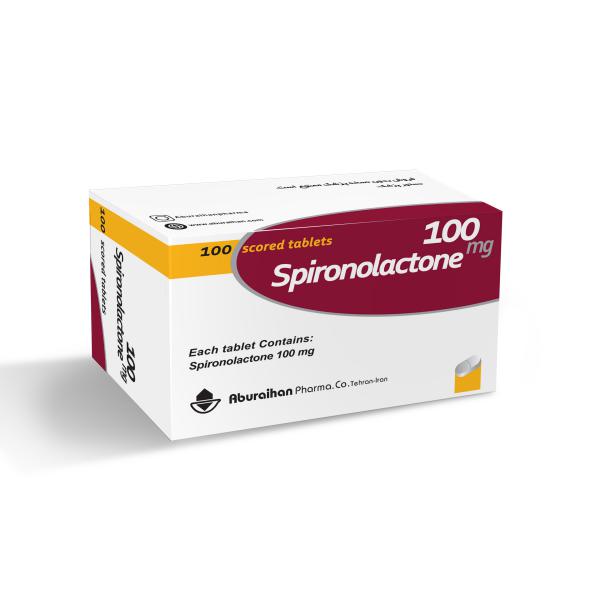Spironolactone
Spironolactone
Tablet
Ascites due to cirrhosis: Management of edema in cirrhosis of the liver unresponsive to fluid and sodium restriction.
Heart failure with reduced ejection fraction: To increase survival, manage edema, and reduce need for hospitalization in patients with heart failure with reduced ejection fraction and New York Heart Association class III to IV symptoms; usually administered in conjunction with other heart failure therapies.
Hypertension, chronic: Management of hypertension unresponsive to other therapies.
Primary hyperaldosteronism (tablet only): Short-term preoperative treatment of primary hyperaldosteronism; long-term maintenance therapy for patients with discrete aldosterone-producing adrenal adenomas who are not candidates for surgery; long-term maintenance therapy for bilateral microor macronodular adrenal hyperplasia (idiopathic hyperaldosteronism).
Mechanism of Action:
Competes with aldosterone for receptor sites in the distal renal tubules, increasing sodium chloride and water excretion while conserving potassium and hydrogen ions; may block the effect of aldosterone on arteriolar smooth muscle as well.
Method of Administration:
Acne vulgaris, females (alternative agent) (off-label use):
Tablet: Oral: Initial: 25 to 50 mg/day in 1 to 2 divided doses; titrate as needed based on response and tolerability to a usual effective dose of 50 to 100 mg/day in 1 to 2 divided doses; maximum dose: 200 mg/day.
Ascites due to cirrhosis:
Tablet: Oral: Initial: 100 mg once daily; titrate every 3 to 5 days based on response and tolerability; usual maximum dose: 400 mg once daily
Heart failure:
Tablet: Oral: Initial: 12.5 mg once daily; may double the dose every 4 weeks if serum potassium remains <5 mEq/L and renal function is stable, up to a maximum target dose of 50 mg/day in 1 or 2 divided doses
Hirsutism, females (alternative agent) (off-label use):
Tablet: Oral: Initial: 50 mg twice daily; may increase to 100 mg twice daily as needed. Assess response at 6-month intervals before adjusting dose, adding additional agents, or switching to alternative therapy
Notes
Hyperkalemia; Addison disease; concomitant use with eplerenone.
Interactions:
CYP2C8 Substrates (Narrow Therapeutic Index/Sensitive with Inhibitors): Spironolactone may increase the serum concentration of CYP2C8 Substrates (Narrow Therapeutic Index/Sensitive with Inhibitors). Risk C: Monitor therapy
CYP3A4 Substrates (Narrow Therapeutic Index/Sensitive with Inhibitors): Spironolactone may increase the serum concentration of CYP3A4 Substrates (Narrow Therapeutic Index/Sensitive with Inhibitors). Risk C: Monitor therapy
Pregnancy and Lactation:
Spironolactone crosses the placenta.
Based on the mechanism of action and data from animal reproduction studies, in utero exposure to spironolactone may cause feminization of a male fetus.
The active metabolite of spironolactone is present in breast milk. The decision to breastfeed during therapy should consider the risk of infant exposure, the benefits of breastfeeding to the infant, and benefits of treatment to the mother.
Warning and Precaution:
- Fluid/electrolyte imbalance: Fluid and electrolyte imbalance (eg, hypomagnesemia, hyponatremia, hypocalcemia, hyperglycemia, hyperkalemia) may occur. Patients with heart failure, renal disease, or cirrhosis may be particularly susceptible. Monitor and correct electrolyte disturbances; adjust dose to avoid dehydration.
Adverse Reactions:
Cardiovascular: Vasculitis
Dermatologic: Chloasma, erythematous maculopapular rash, pruritus, Stevens-Johnson syndrome, toxic epidermal necrolysis, urticaria
Endocrine & metabolic: Amenorrhea, decreased libido, hyperglycemia, hypocalcemia, hypomagnesemia, hyponatremia, hypovolemia
Gastrointestinal: Abdominal cramps, diarrhea, gastritis, gastrointestinal hemorrhage, gastrointestinal ulcer, nausea, vomiting
Genitourinary: Erectile dysfunction, irregular menses, mastalgia, postmenopausal bleeding
Hematologic & oncologic: Agranulocytosis, leukopenia, thrombocytopenia
Hepatic: Hepatotoxicity
Hypersensitivity: Anaphylaxis
Immunologic: Drug reaction with eosinophilia and systemic symptoms
Nervous system: Ataxia, confusion, dizziness, drowsiness, headache, lethargy, nipple pain
Neuromuscular & skeletal: Lower limb cramp
Renal: Renal failure syndrome, renal insufficiency
Storage:
Store below 30ºC and protect from light and moisture.


